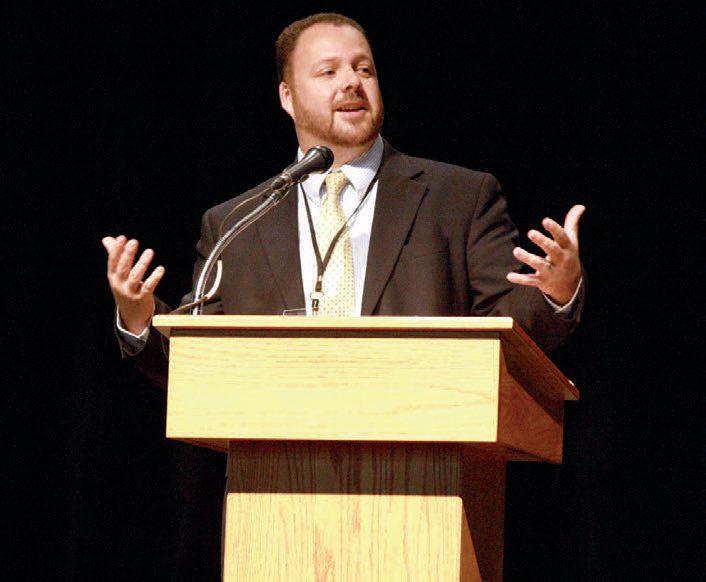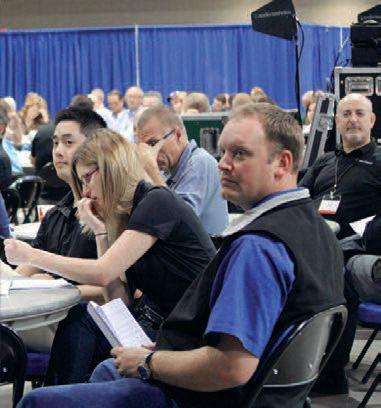
3 minute read
Controlling the chaos
City planners, developers gather to explore Bakken’s continuing development needs
BY KRIS BEVILL
More than 200 developers, investors and local officials gathered in Bismarck, N.D., in late September for the Bakken Construction Summit. Hosted by Williston-based Dawa Solutions Group, the conference was held to bring together interested parties to explore development needs in western North Dakota and provide them with information needed to successfully and thoughtfully improve infrastructure, provide housing and develop other necessities critical to serving the area’s rapidly growing population.
The theme of the event — Exploring a Billion Dollar Construction Market — was based on 2012 building permit valuations from Bakken hub cities and city planners who presented at the conference indicated that development activities throughout the area will continue at a fast and furious pace for the foreseeable future.
Matt Kolling, city attorney and assistant administrator for the city of Dickinson, demonstrated the rate of growth being experienced there by noting that when Dickinson issued $57 million in new construction permits in 2009 it set a new record.
Last year, Dickinson’s new construction permits were valued at a whopping $389 million. Through August this year, the city issued $246 million in new construction permits.
Kolling said he doesn’t expect Dickinson’s final building permit valuations this year to match 2012, partially because a late spring dampened construction efforts but also because the city has adopted a more measured approach to approving new developments. “We don’t want to be a boom town,” he said. However he did note that the city is currently tracking 90 development projects in its immediate proximity, including the MDU Resources-Calumet Specialty Products diesel refinery, known as Dakota Prairie Refinery, which is currently under construction and expected to be complete in 2014.
Dickinson city officials have struggled to keep up with the ballooning workloads and infrastructure needs, but Kolling said the city budget has grown from $21 million in 2010 to $73.4 million this year and is in the process of hiring more personnel. The city is expected to grow in population from an estimated 28,000 permanent residents currently to about 42,000 residents in 2035, and is expected to require up to $526 million of capital investments in public infrastructure over the course of that time period. Expanded water infrastructure is among the city’s most dire needs. Kolling said the city’s current system has a capacity of 6 million gallons per day. This summer saw a period of use that reached 5.8 million gallons per day.
Williams County Planning Director Ray Pacheco addressed the wait times for project approvals and recent development moratoriums during his presentation, emphasizing his office’s efforts to “control the chaos” that has occurred around Williston and throughout the county over the past few years as development activity surged. “We’re trying to fix it,” he said. “We’re trying to clean things up.” Included on Pacheco’s list of items to be addressed is improved regulation of crew camps and thorough reviews of newly proposed projects. Proper oversight takes time and he admitted his office is also understaffed, but said new employees were being added to help alleviate some of the backlog. The start-to-finish timeline for project approval is about two months, he said. Pacheco, who joined the county’s planning office just five months ago, said he was currently in the process of rewriting the county’s zoning rules to offer some flexibility in development projects. If approved, he said the rules could be in place Jan. 1.
At just 24 years old, Watford City Assistant Planner Seth Sampson was likely one of the youngest, and busiest, conference attendees. Sampson has been in his role at Watford City for four months, but learned quickly that development in the Bakken’s latest hotbed of activity moves to the beat of its own drum. “Throw what you know about development out the window when you come to Watford City,” he told attendees. “It’s unlike anywhere else.”
Watford City had an estimated population of less than 2,000 people just two years ago. Today, it is estimated to have 8,000 people living within city limits and another 4,000 people on its fringes, Sampson said. The city is expected to require $284 million in infrastructure expansions over the next four years, including a $56 million wastewater treatment plant that Sampson said is first on the list of must-haves. He said the city has witnessed an influx of developer interest recently and expects the next two years to be “even more rapid and chaotic.” Current housing projects recently completed or under construction in the Watford City area include a 270-acre development, a 280-acre development and a 90-acre development, among others. To put it into context, Sampson said new housing projects already on the books will more than triple the town’s size.
Public officials stressed a desire for developers to propose projects for single-family and townhome developments rather than apartment units and urged caution when considering hotel projects, noting that many new hotels have come online recently and the need for additional hotels is limited. There continues to be a significant need for commercial space throughout the region, however. Several speakers indicated that as housing projects have begun to catch up with demand, commercial development has become more feasible and they anticipate quick ramp-ups of activity in that area in the coming construction season. PB

Kris Bevill Editor, Prairie Business 701-306-8561, kbevill@prairiebizmag.com










